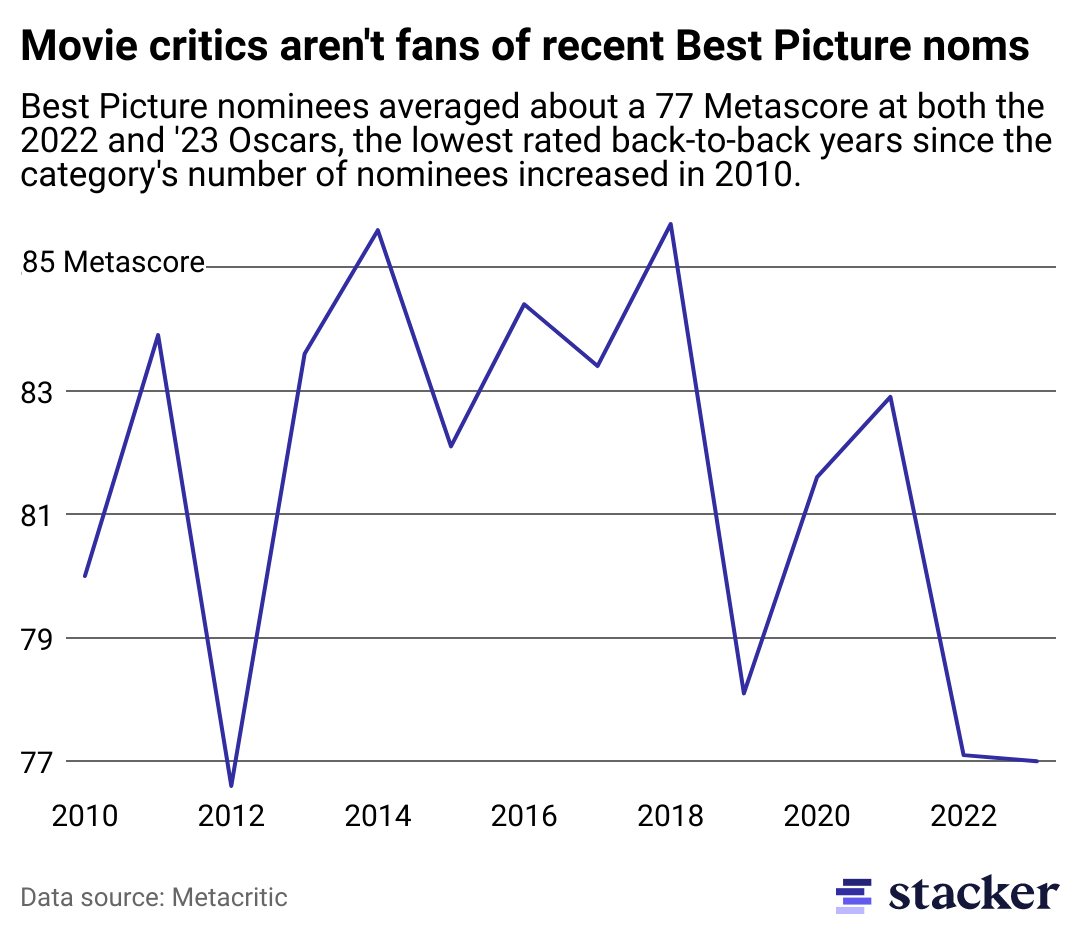The 2023 Best Picture Oscar nominees are less critically acclaimed, but do they reflect moviegoer tastes?

LanKS // Shutterstock
The 2023 Best Picture Oscar nominees are less critically acclaimed, but do they reflect moviegoer tastes?
Award statue with film background.
Debating the Academy Awards is a pastime that dates back to at least the discovery of the Africus monolith in “2001: A Space Odyssey.”
One need look no further than when “Crash” beat out “Brokeback Mountain” for Best Picture in 2006—in a shocking upset—as a common example of controversial Oscar wins. Then there’s Rami Malek winning Best Actor in 2019 for his performance as Freddy Mercury in the widely panned (but financially successful) “Bohemian Rhapsody” as another example of what some thought to be a confounding Academy choice. And who could forget when Roman Polanski landed a Best Director win for “The Pianist” in 2003 despite not being able to come to the ceremony due to an outstanding warrant for statutory rape.
It’s hard to find a consensus on anything related to the Oscars (except, perhaps, that last year’s slap is now a widely recognized cultural moment etched into the annals of Hollywood). But there is one area that can be analyzed to divine some sense of agreement: the data behind critical reviews of Oscar nominees. And the recent numbers are not pretty for the Best Picture category—the quality of films nominated for the Academy’s most prestigious award has dipped as of late, at least according to critics. However, data also suggests that recent Oscar nominees have seen a boost in audience engagement through box office receipts.
For this data dive, Stacker analyzed critical review metrics from Metacritic and box office data from The Numbers to look at Best Picture nominations at the Academy Awards. Unless otherwise stated, the analysis goes back to 2010, the first year the Best Picture slate had an increased number of nominees. Read on to learn more about the critical acclaim—or lack thereof—of recent Oscar-nominated films, and how it compares to box office success.
You may also like: Different movies with the same plots
![]()

Stacker
Best Picture noms at the Oscars are in a two-year rut when it comes to critical reception
Line chart showing average Metascore of Best Picture nominated films at the Oscars from 2010 to 2023.
The data paints a straightforward, but dour, sight. This year’s Best Picture nominees average a 77.0 Metascore—what Metacritic calls its weighted average of critic reviews. That’s roughly on par with last year’s 77.1 average and, when put together, the Best Picture nominees in 2022 and 2023 make up the lowest critically rated two-year stretch since the Academy expanded the number of Best Picture nominees in 2010.
After widening the data set to include years when the Best Picture category featured five nominations, the data shows the last back-to-back year rut (which was just as discouraging as the current run) occurred at the end of the 20th century. Back then, the 1998, 1999, 2000, and 2001 ceremonies had a set of Best Picture nominees with an average Metascore of 78 or lower. Besides that three-year span, the 1980s and early ’90s were a particularly dark era for Best Picture nominations—between 1984 and 1993, only one year managed to reach an average Metascore of at least 80 (the outlier was 1987 when the Charlie Sheen-led “Platoon” nabbed Best Picture).
In both cases, the Oscars broke out of its doldrums in fine style. Led by films “Schindler’s List,” “The Piano,” and “The Fugitive,” 1994 was the highest-rated year for Best Picture nominees in the past 40 years with an average Metascore of 88.2. The 2000s, meanwhile, were paced by well-received Best Picture nominations for films such as “Crouching Tiger, Hidden Dragon,” “The Lord of the Rings” movies, and “No Country For Old Men.”
So the Oscars have been here before; in a low-rated era filled with middling Best Picture nominees, and it managed to power through hard times with some quality films down the line. However, critical reviews don’t tell the full story.
This year particularly succeeds by including blockbuster movies that excited fans at the box offices in U.S. and Canada. Among the 2023 Best Picture nominees, “Top Gun: Maverick” (#1 grossing movie of 2022), “Avatar: The Way of Water” (#3), and “Elvis” (#12) all drew fans to the theaters in droves, according to domestic box office data from The Numbers.
With the inclusion of James Cameron’s second “Avatar” movie and the sequel to the Tom Cruise classic “Top Gun,” 2023 is the first time in the past decade that two top 10 grossing films were nominated for the top film award at the Oscars. In fact, you’d have to go back to 2011 to find the last time two top 10 grossing films were nominated for Best Picture (that year, “Toy Story 3” and “Inception” were among the nominees).
Analyzing nominees among the top 20 grossing movies of the year reveals a similar pattern—in recent years, only 2019 also had three domestic top 20 grossing movies with “Black Panther,” “A Star Is Born,” and “Bohemian Rhapsody” (it’s also worth noting that this same year’s Best Picture nominees fared poorly in critics’ eyes with an average Metascore of 78.1).
Averaging the box office ranking of Best Picture nominees in a single year also offers insight into the level of familiarity audiences have with the nominated films. This year’s nominees averaged a rank of 73.1 at the annual box office. Last year’s fared about the same with an average ranking of 72.1. In 2021, that average was 94.4 (though it should be noted this year’s ceremony was for films that came out in 2020—the first year of the COVID-19 pandemic, which significantly impacted movie theater attendance).
In the 14 years since the Oscars expanded the number of Best Picture nominees, the average box office ranking of each year’s nomination slate broke 100 (i.e., ranked on average between #1 and #99) eight times—twice as many in the 14-year period before the category’s expansion. Based on this trend, it appears the Academy is starting to highlight more fan favorites. The past few years are a step in the right direction, but the Oscars could do more work in ensuring more well-reviewed films that also do well at the box office are better represented.
Ultimately, that difference—what fans like versus critics versus Academy members—seems to be the crux of the quality question facing the Oscars. Who decides what is a “good” or “bad” movie? And what type of movie is “best” for the Academy Awards? Fans, critics, and the Academy have long had differing opinions, and the debates are unlikely to die down anytime soon.